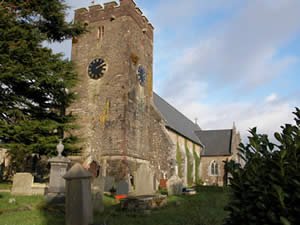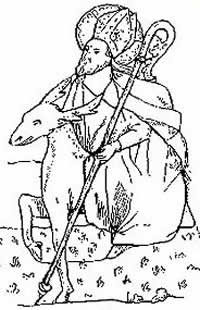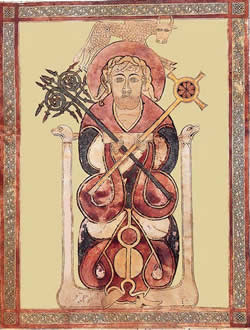The Parish Church of Llandeilo Fawr
St Teilo's Church

Church History
A visitor to Llandeilo cannot help noticing the church, which, with its enormous churchyard, is the town's most conspicuous feature. The church building which you see today was completed in 1850; the tower is late medieval. But the churchyard and the site on which the church stands have a much longer history.
Llandeilo's history as a known Christian centre dates from the sixth century. It was in the course of that century, probably towards its close, that one of the major Christian figures of Welsh history, St.Teilo, chose to make it his base.
We know very little for certain about Teilo. The churches dedicated to him are spread around South Wales, and occur also in Brittany. This distribution of his cult makes it seem likely that he travelled over this area. Two Lives of St.Teilo were written in the twelfth century, and purport to give a lot of detail about the saint, but are an inextricable mixture of local legends (with a probable core of historical fact) and pure invention.
While there is almost nothing which we can know for certain about Teilo, probable facts about him are these: he travelled through South Wales and in Brittany; he made Llandeilo his centre (its site on or near a Roman road gave it good communications to east and west); he founded a community in Llandeilo; he was buried at Llandeilo. Llandaff later claimed to have his body, but as late as the thirteenth century, visitors to Llandeilo, including King Edward I, were shown Teilo's tomb in the church here.
One of the most celebrated legends about him tells how, on his death at Llandeilo, three churches claimed his body: Penally (his birthplace), Llandeilo Fawr (his chief church), and Llandaff. The clergy of the three churches prayed, then left the body in the church. In the morning, the body was found to have been miraculously triplicated, so that each church could have an authentic body to bury!

"Archbishop" of Llandaff, born at Eccluis Gunniau, near Tenby, Pembrokeshire; died at Llandilo Vawr, Carmarthenshire, probably in or before 560, an old man, but Ussher puts his death at 604. Sir John Rhys thinks that his true name was Eliau or Eilliau; in Latin it usually appears as Teliarus, in Breton as Teliau, and in French as Télo. He was cousin to St. David and born of a good family settled at Penally, near Tenby. His father, whose name was probably Usyllt, may possibly be identified with St. Issell, the patron of the parish church of Saundersfoot. His sister Anaumed, or Anauved, married King Budic of Armorica, and became the mother of St. Oudaceus, Teilo's successor.
The earliest extant biographies of the saint are late and uncritical. Educated under St. Dyfrig or Dubric, at Hentland, Herefordshire, and under St. Paul the Old or Paulinus at Whitland, Carmarthenshire, he subsequently ruled the monastic school at Llandaff, named after him Bangor Deilo.
The story of his visit to Palestine with Saints David and Padarn (or Paternus) about 518, and their consecration there as bishops by John III, Patriarch of Jerusalem, is not now generally credited; but it seems that about that date, when St. Dubric withdrew to Bardsey, St. Teilo succeeded him at Llandaff. In 547 the "yellow plague" began to ravage Wales, and shortly afterwards St. Teilo with many of his flock crossed to Armorica, where they were hospitably entertained by his friend St. Sampson, Abbot and Bishop of Dol. After seven years and seven months Teilo returned to Wales, and is said to have been elected to the archiepiscopate vacant by the death of St. David, and to have transferred it from Menevia to Llandaff; but the more general modern opinion seems to be that in Wales at that epoch the episcopate was not yet diocesan.
The story of the three bodies of the saint, which were discovered the day after his death, was probably invited to account for the fact that the churches at Llandaff, Llandilo Vawr, and Penally, all claimed to possess his body. Doubtless at his death his relics were widely distributed. Today they are venerated at Landeleau (Finistère), Plogonnac (Finistère), and Saint Télo (Côtes-du-Nord). Five parish churches in Brittany are dedicated to him (Landeleau, Leuhan, Montertelot, Plédéliac, and Saint Télo) as well as a chapel between Plogonnac and Locronan. The modern Catholic church at Tenby bears the names of "Holyrood and St. Teilo". The dedication of twelve churches in the present Anglican Diocese of St. David's, and of six in that of Llandaff, show they owe their origin to this zeal. Borlase argues his connection with six dedications in Cornwall and Devon. It is stated that he was formally canonized, but no date is given. He is not infrequently represented in Breton churches as riding on a stag. His festival is, or was, kept in Wales and at Saint Télo on 9 February; at Dol, was a double, on 29 November; and in other places in Brittany on 25 November.
JOHN B. WAINEWRIGHT
Transcribed by Christine J. Murray

The Early Years of Llandeilo Fawr
The church which Teilo left behind soon came to be called Llandeilo Fawr , 'The Great Llan , or church, of St.Teilo', and the centre of a religious community. Llandeilo's greatest treasure was a fine gospel book, written probably in the eighth century, and donated to the community c.820 by a man named Gelhi, who had bought it and had given it 'to the altar of St.Teilo'. The margins of the gospel book were used in the ninth century to record land transactions, and settlements of legal actions. These short passages are of enormous importance, because they form the oldest surviving examples of written Welsh, and tell us something about social and ecclesiastical conditions at this early period. They tell us, for instance, that there was a bishop at Llandeilo Fawr in the ninth century.
Before the end of the eleventh century, the Llandeilo gospel book had been taken to Lichfield, where it remains today (it is displayed in the cathedral as the Lichfield or St.Chad Gospels). No-one knows how the transfer was made, but a likely guess is that it was given as tribute to a Saxon king by one of the Welsh princes of the period.Opening of the Llandeilo Gospels Exhibition
By means of sophisticated digital technology, the Llandeilo Gospel Book can be seen again in Llandeilo, where it spent such a significant part of its early history. The Gospels Exhibition was officially opened by the Bishop of St David's, Rt Rev Carl Cooper, and the Chairman of Carmarthenshire County Council, Cllr Jim Jones, on Friday 24th February. The highlight of the occasion was a lecture by Professor Michelle Brown on the art and history of the Gospel book.
On the following day, Saturday 25th February, a ceremony was held in Lichfield Cathedral to inaugurate a similar display of the book.
The Exhibition has been made possible by a grant of £74,528 of European Objective One funding from the 1FUND administered by Carmarthenshire County Council for the Welsh Assembly Government. The successful grant application was made with the assistance of Menter Bro Dinefwr.
An exhibition space, designed by the Regan Norris Partnership, has been created under the Medieval tower of Llandeilo Parish Church, to which visitors are welcome at the times stated below.
The exhibition will be open to the public, Easter—September at the following times. Admission is free.
- Tuesday
- 11.00am - 1.30pm
- Wednesday
- 11.30am - 1.30pm
- Thursday
- 11.00am - 1.30pm
- Friday
- 11.00am - 4.00pm
- Saturday
- 11.00am - 4.00pm
Note in 2016 the Gospels will open on 3rd May
Group visits welcomed throughout the year by prior arrangement (01558 822371). Education materials (KS 2) available for schools. Disabled access and facilities.
For the latest details please see the Parish of Llandeilo Fawr website.
Later History
Llandeilo Fawr lost something of its ecclesiastical importance between 900 and 1200AD. In the ninth century it was the seat of a bishop. By 1200 it was a parish church, but with a very extensive parish covering some 20,000 acres. Llandeilo Fawr was also a wealthy parish, but its revenues, together with the lands of the old Teilo community were transferred to the abbey of Talley in the twelfth century,
The church was rebuilt in 1848-50. The pre-1848 building was a late medieval structure of c.1400. The tower is the only surviving feature of that building above ground. The rebuilders of 1848 chose to use the existing medieval foundations, so that the ground plan of the present church reproduces that of the medieval building. The present building was designed by Edward Davies, an architect from Bath, and built under the supervision of George Gilbert Scott.
This church continues its witness to Jesus Christ through its life and ministry today and for the future.
The Church Building
The Foyer
The foyer contains a funerary monument to Morgan Jones, of Tregib (the initials at the foot give his name M [organ] J [ones, son of] H [arry]). The date is given by the numerals in the corners: 1580. It is one of the earliest armorial monuments in any Welsh church. Also in the foyer is the font from Llandyfeisant church, which was closed in 1961.
The Nave
At the opening of the present building in 1850, the nave was a vast one, seating some 700 people. In 1979 the north aisle was divided off to create a hall area within the building, together with a kitchen and conveniences, to adapt the building to the needs of the parish.
In the nave may be seen four stained glass windows, of which the westernmost is the war memorial window from Llandyfeisant church, and its neighbour (the nativity scene) is from the celebrated glass workshops of Kempe & Co.(1909).
The Chancel
The first organ in the church was built in 1829 at the west end of the church, where (before 1905) there was a singing gallery. The present organ casing (by Postill of York) was installed in 1857, and is believed to have come from Ripon Cathedral. The organ remained at the west end until a new organ chamber was constructed in 1905, when the 1857 casing was moved up to the chancel, and all new works were installed by Vowles of Bristol. Monuments on the walls commemorate members of the family of Tregib mansion. There are monuments also to John Griffiths (Vicar 1852-78: a notable Evangelical of the Victorian church in Wales), and to Archdeacon Thomas Beynon (Vicar of Llandyfeisant 1770-1833: an outstanding influence on the revival of Welsh cultural traditions in the nineteenth century). Griffiths' monument, by Hardman & Co. of Birmingham, was erected in 1883.
The East window, which strikes the visitor on entering church, is a war memorial (1921) by the Whitefriars studio of James Powell & Son. It is complemented by the town's war memorial on the panels along the east wall.
The Hall
The east end of the hall (formerly the north aisle of the church) is formed by the old family chapel of the Rices of Dynevor. Family monuments from the eighteenth to twentieth centuries are on the walls, while a cover in the floor gives access to the family vault, together with that of the Carbery family of Golden Grove.
On the window ledges may be seen Llandeilo's two cross heads, discovered in the ground during the rebuilding of 1848-50. The shafts on which they once stood are lost, and perhaps have been incorporated into the church walls. They date from c.900AD, and each has a cross within a rectilinear design, though one also has a cross made of circles on one face (the face displayed). This rectilinear design is thought to be unique to the Llandeilo crosses. Their presence here is a reminder of the former importance of Llandeilo Fawr as a Christian centre between about 800 and 1000AD.
The Churchyard
The churchyard's large size (about three and a half acres) and its oval shape are both typical of an ancient llan , or church enclosure. The road running through it was laid out as a turnpike in the late eighteenth century.
A fair, called Barnaby Fair, was for centuries held in the churchyard on St.Barnabas' day (June 11th). The first reference to it comes in 1291, and it was still being held well into the nineteenth century.
On the south side of the churchyard, in the wall along Church Street, may be seen an alcove in which a small conduit carries water from a spring in the churchyard itself. This is the outlet from St.Teilo's well which is situated near the eastern end of the church. The well supplied the townsfolk with water for centuries, until covered over in the mid nineteenth century. It is probably a sacred spring, perhaps used as a baptistry from early times.
This church continues its witness to Jesus Christ through its life and ministry today and for the future.
From: www.llandeilofawr.org.uk